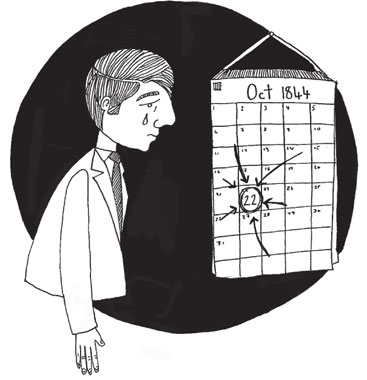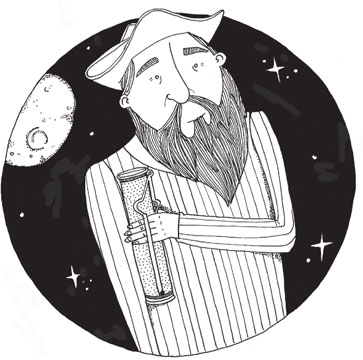The Little Book of the End of the World (13 page)
Read The Little Book of the End of the World Online
Authors: Ken Mooney

Joseph Smith supposedly referenced politics and the End of the World in his White Horse Prophecy. However, since this prophecy was not recorded or made public by Smith during his lifetime, it’s possible that it was made by a follower who used Smith’s name to gain more weight for his own views.
In this prophecy, Smith spoke about the American people migrating towards the Rocky Mountains and being seen as a white horse of peace and safety; the time would come when the US Constitution would hang by a thread, and the nation would be saved by the efforts of a white horse and a red horse coming together in its defence.
Some interpretations see a racial undertone to Smith’s prophecy, with the US Constitution being saved only by white and ‘red’ – understood to mean Native American – peoples working together. However, the biblical association with the Four Horsemen cannot be ignored.
The Mormon Church does not make specific prophecies with regards to the date or time of the Apocalypse but, like Jehovah’s Witnesses, they do believe that the Endtimes are imminent, with many current political events acting as a fulfilment of the biblical prophecies hinted at in Revelations.
ADVENTISM
In 1833, William Miller founded a new movement that saw the imminent Second Coming. Miller’s beliefs came from a close reading of the Bible, and as he continued to study, he found further support for his ideas. A devout Baptist, Miller met with some scepticism when he made his discovery public, but as he revealed more about his method and the studies that he had undertaken, he gathered a following that spread around the world.
Like many predicted dates for the End of the World, Miller revised his figures a number of times. But he and his followers were convinced that one date in particular would be important for the Second Coming: 22 October 1844.

The Great Disappointment
Miller derived dates for the Second Coming from the Book of Daniel; with some complicated mathematics that converted the classical Jewish calendar to the modern Gregorian calendar, Miller arrived at the range of years during which the world would end.
He suggested that this would be between March 1843 and March 1844, but he would not be drawn on a more specific date.
Miller and his followers prepared for the end, but March 1844 came and went with no apocalyptic events. Miller pushed his date back by a month to April, but this also bore no fruit. However, Samuel Snow, a colleague and friend of Miller, made further adjustments to the formula, narrowing down Miller’s vague predictions and coming up with the specific date of 22 October.
Finally with a specific date to circle on their calendars, Millerites and Adventists began to take steps that they had only discussed until now, with many followers giving up their worldly possessions in preparation for the End of the World.
As you can probably guess by reading this book hundreds of years later, the world did not end on 22 October, with Miller and his faith becoming a point of ridicule around the world. Although Miller lost many followers, he continued to study the Bible and waited for the Second Coming until his own death in 1849.
The Bahá’i faith suggests that the arrival and declaration of the Báb coincides with this potential end, and may have fulfilled Miller’s prophecy: the Báb first revealed himself in April 1844, and in October 1844 undertook a pilgrimage to Mecca where he made his announcement public.
THE STRANGE CASE OF JOANNA SOUTHCOTT
Joanna Southcott was born in 1750 in Devon and spent her life working as a housemaid and farm worker. Around the age of 50, Joanna began to receive visions which she believed to be prophecies sent from God. After some of her minor prophecies came true, Joanna’s writings were adopted by a small group of believers, with Joanna becoming a minor celebrity.
In 1814, at 64 years of age, Joanna announced that she was four months pregnant. As a virgin who had never married, Joanna believed that her pregnancy was a gift from God and that her child would be the Second Coming of Jesus Christ – it was not difficult to convince her followers of that same fact. Joanna even wrote about some of the symptoms of her pregnancy, describing in great detail the movements within her womb as she grew to a large size.
After Southcott had gone well past term, she came to believe that Jesus Christ would not be born to an unmarried woman. Replicating the family of Jesus, Mary and Joseph, Joanna married one of her followers, John Smith, with an agreement that the marriage would be annulled if the child was not born.
Southcott passed away in December 1814, supposedly fourteen months pregnant, with no sign of any child. An autopsy was held on her corpse, attended by several followers and medical doctors. No sign of pregnancy was found. Instead, Joanna’s abdomen had swollen to nearly four times the usual size thanks to a build-up of fat and gas.
With no sign of a Second Coming, her followers disbanded, suitably deflated that the End of the World had not come to pass.
11
PORTENTS OF THE END: NOSTRADAMUS AND PROPHECIES
NOSTRADAMUS
Michel de Nostradame, known by the pen-name Nostradamus, is a notorious figure when discussing the End of the World, and no book discussing the Apocalypse would be complete without referencing him.
Born in France in the early sixteenth century, Nostradamus was an apothecary – a posh, old-fashioned name for a chemist – and seer. After years of studying and practicing medicine, Nostradamus published his first almanac in 1550, collecting a number of predictions that he had previously made. He published the book under the Latinised version of his own name, the sixteenth-century equivalent of the heavy-metal umlaut. Some of these predictions were specific, involving weather or crops, others were significantly vaguer.
This almanac sold so successfully that Nostradamus was encouraged to write more, publishing over 6,000 prophecies and star charts. He also entered into correspondence with dignitaries and nobles, both from his native France and internationally, creating personalised star charts and predictions for them and their families.

One such noblewoman to embrace Nostradamus – or perhaps respond in fear to the fact that such prophecies existed – was Catherine de Medici, the wife of King Henry II of France. Nostradamus initially feared for his life when contacted by Catherine, but she was so convinced by his prophetic words that she hired him as the family’s personal physician.
Fearing repercussions from both the Crown and the Church, Nostradamus adopted a sort of code for his prophecies, which became similar to the Book of Revelations: by using Latin, Greek and other contemporary languages, Nostradamus hid his own meanings. While it kept Nostradamus alive, it also meant that his predictions could apply to multiple things at once and were usually only attributed as correct after an occurrence that fulfilled them.
In 1555, Nostradamus published another book of prediction, called
Les Propheties
or
The Prophecies
. He took this opportunity to downplay the involvement of any ‘magic’ or occultism in his predictions. Instead, he associated historic events with the positions and alignments of the planets and stars, suggesting that similar events would occur again when the planets were next in a similar position.
This made Nostradamus one of the first people to apply a scientific approach to prophecies and the End of the World, but he certainly was not the last: science and faith would continue to intertwine, creating new approaches to religion that bordered on the occult.
Nostradamus’ prophecies were condemned by both contemporary scientists and clergy, but the legacy of his work has lasted to the present day, and readers have suggested that he predicted the French revolution, the rise of Hitler, the atomic bomb and the 9/11 terrorist attack on the World Trade Center.
Nostradamus’ prophecies are curiously quiet on the End of the World, however – or rather very few interpretations point towards a definite series of events leading to it. But perhaps these will only be discussed after the Endtimes have happened.
Some conspiracy theories suggest that there is a Cult of Nostradamus, possessing secret knowledge of these prophecies, either holding some key to translating them or possessing some predictions that have not been made public.
This cult supposedly uses this knowledge to manipulate events in their own favour; as befitting any conspiracy theory, political leaders and businessmen are rumoured to be amongst the most senior members of the cult.
As with the best conspiracy theories, there’s little proof that the Cult of Nostradamus exists, but if you look for it hard enough, you could probably convince yourself that it’s true.
Nostradamus’ reputation is not limited to poetic verses, as a number of abstract paintings are also named after him, the
Vaticinia Nostradami
. The paintings were found with a covering letter that suggested they were inspired by Nostradamus, but examination suggests that they are actually older.
The paintings feature surreal imagery and symbols of saints and beasts, similar to those discussed in Revelations. The content of the
Vaticinia Nostradami
is also similar to the Chinese
Tui bei tu
, an illustrated poem that features similar prophecies.
THE PROPHECY OF THE POPES
Although St Patrick is the patron saint of Ireland, he wasn’t born there – like Georgius, Patrick is the patron saint of a nation to which he was not born. Unlike Georgius, Patrick actually did spend most of his life in Ireland after being born in Britain – probably Wales or Cumbria.
Instead, the first native Irishman to be conferred with sainthood was Saint Malachy, Archbishop of Armagh from approximately 1132 to 1137. Centuries after Malachy’s death, the Prophecy of the Popes was published by a Benedictine monk, Arnold Wion. It’s unclear if the prophecy was attributed to Malachy or if Wion simply used Malachy’s name on his own prediction – as with Nostradamus’ Latinised name, he could avoid repercussions by blaming someone else.
The prophecy consists of 112 short Latin phrases, with each verse dedicated to a different pope, and it also suggests that these 112 popes provide a sort of countdown to the Last Judgement, which will coincide with the final pope.
Like Nostradamus’ predictions, most of the Prophecy of the Popes can be manipulated after the fact and interpreted in different ways – most of the prophecies only make sense after the next pope has come to power. As if to prove the point, many of the earliest verses describe their corresponding popes in great detail, including facts about their early lives and places of birth; on the other hand, later entries are brief and vague.
However, the Prophecy of the Popes is one to pay close attention to: Pope Francis, elected to the Papacy in March 2013, is the 112th pope on this list. As of writing this book, it remains to be seen whether he will be the ‘
Petrus Romanus’
, who reigns over the Church during the Endtimes.
CHRISTOPHER COLUMBUS
Columbus is best known as an explorer, the captain responsible for the ‘discovery’ of the American continent in 1492. Of course, the importance placed on Columbus neglects that the continent had been inhabited for thousands of years, by both natives and Norse colonists.
But Columbus also made his own small contribution to the wealth of apocalyptic literature: he wrote and published his
Book of Prophecies
in the early years of sixteenth century.
In this book, Columbus sets out four things that he believed would herald the End of the World:
![]() Christianity would spread across the world.
Christianity would spread across the world.
